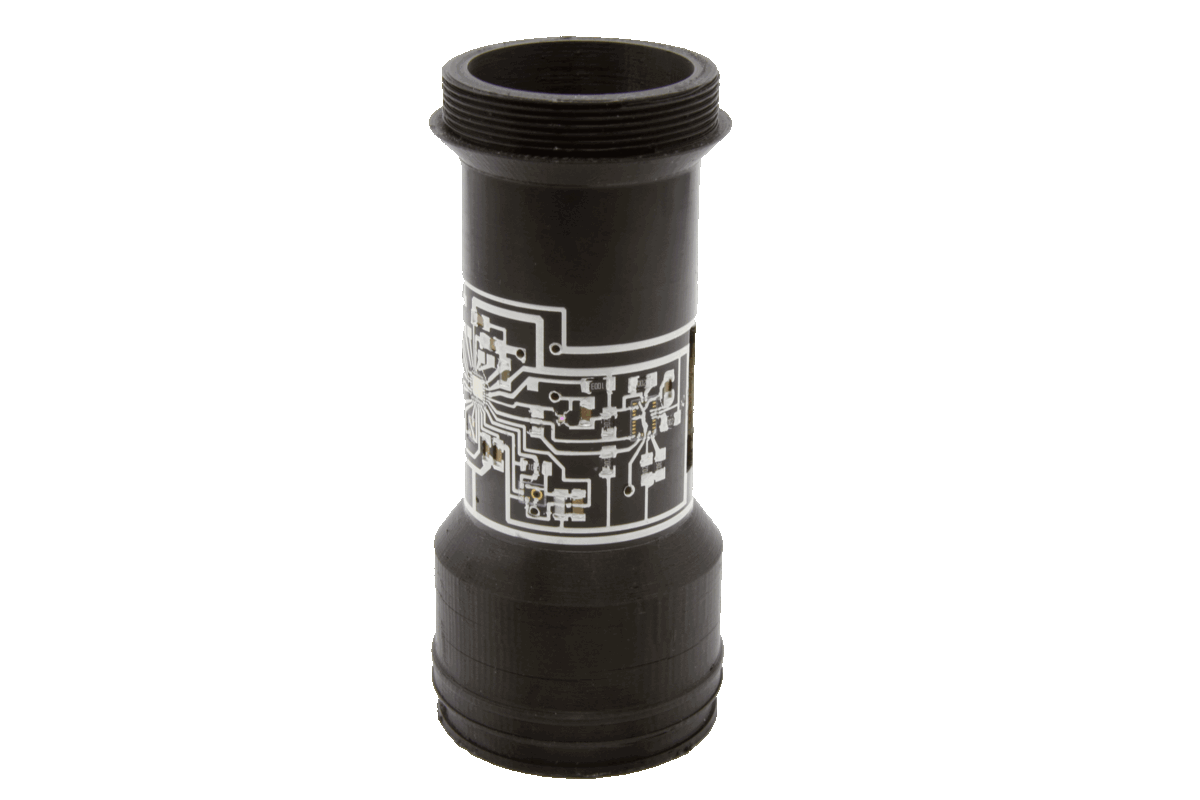When it comes to rugged 3D printers, Florida-based manufacturer nScrypt is one of the first names that pops in my mind. The company designs and builds high-precision microdispensing and 3D printing solutions for industrial applications, often used by the military and government agencies, for the printed electronics, communications, defense, space, and printed antenna sectors, among others. Now, nScrypt has 3D printed a functional, rugged, precision electronic sensing device on a cylinder, using its multi-axis Factory in a Tool (FiT) system.
nScrypt has plenty of experience 3D printing electronics; while exciting as always, that’s not the big news here. The fact that the electronic sensor was printed on a cylindrical shape is the headliner.
“Manufacturing a traditionally planar circuit on or in a round object is a lot like putting a square peg in a round hole. It’s not a good fit, but we did it and I believe we are the first to do so,” stated nScrypt’s CEO Dr. Ken Church. “Cylindrically printed circuits can allow for volumetric savings in areas where traditional PCB’s fall flat. Traditional, flat PCB’s would be forced to occupy valuable real estate inside the cylinder body. But printing electronics and sensor systems in specialty shapes like cylinders or cones and utilizing the curvature of the walls provides unique advantages and innovative form factors. More importantly, by delivering such devices to the point of need, humans can be removed from dangerous situations or remote locations. We start with a CAD file and our Factory in a Tool does the rest, 3D manufacturing a complete, fully functioning, high-precision, multi-material electronic device with virtually unlimited applications for sensing and providing data at a distance.”
Several partners, such as the US Army, have been working with engineers and scientists at nScrypt, and its research arm Sciperio, to change the way that electronics are packaged, delivered to places that require monitoring, such as areas with situations where warfighters or first responders are needed, and send back critical data. One such project is 3D printing a sensor system that will facilitate remote communication between the user-a safe distance away-and the device. The solution is a small, high-precision device with a communications link to a SmartPhone, and printing it in a cylindrical form will allow for much of the functionality to be built right in.
This rugged 3D printed cylinder with conformal circuitry fits a lot of features in its small package, such as a Bluetooth microcontroller, a PC-ABS shell, silver conductive traces and on-board battery power, and embedded printed antenna. It can be fitted with several sensors, including vibration, acoustic, motion, light, and temperature, and subtractive manufacturing was used to fabricate precisely fitted, tight-tolerance cavities for components. The device also features fully embedded components, and its surface can be encapsulated completely in order to protect and hide the circuitry inside.

Cylindrical circuit with a fully functional acoustic sensor platform equipped with Bluetooth communication.
nScrypt used its FiT to print the cylindrical device to what it calls “precise specifications,” and, because it’s a hybrid machine equipped with subtractive technologies, also used the system to mill the surface to tight tolerances that could accept electronic components and circuits, conformally microdispense the circuit on the cylinder’s surface, and pick, place, and embed the electronic components. This one machine offers all those technologies, and can also automatically change toolheads and materials in real time, which must make things so much easier.
People get hung up sometimes on thinking that additive manufacturing is pushing the tried and true subtractive methods out of the way, but I don’t believe that’s the case at all. This cylindrical sensing device on a circuit is a great example of what’s possible when you use all the manufacturing tools at your disposal.
Subscribe to Our Email Newsletter
Stay up-to-date on all the latest news from the 3D printing industry and receive information and offers from third party vendors.
You May Also Like
3D Printing Financials: Fathom Struggles in Financial Quicksand During Critical Transition
Facing a year of key transitions and financial pressures, Fathom (Nasdaq: FTHM) has filed its annual report for 2023 with the U.S. Securities and Exchange Commission (SEC). The document outlines...
Latest Earnings Overview for Australian 3D Printing Firms Titomic and AML3D
Australian 3D printing manufacturing firms Titomic (ASX: TTT) and AML3D (ASX: AL3) reported their financial results for the period from July to December 2023, marking the first half of their...
3D Printing Webinar and Event Roundup: April 7, 2024
Webinars and events in the 3D printing industry are picking back up this week! Sea-Air-Space is coming to Maryland, and SAE International is sponsoring a 3D Systems webinar about 3D...
3D Printing Financials: Unpacking Farsoon and BLT’s 2023 Performance
In the Chinese 3D printing industry, two companies, Farsoon (SHA: 688433) and Bright Laser Technologies, or BLT (SHA: 688333), have recently unveiled their full-year earnings for 2023. Farsoon reported increases...
































